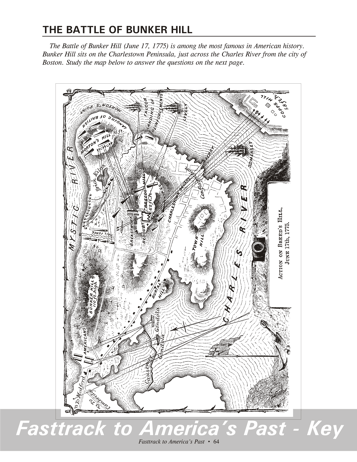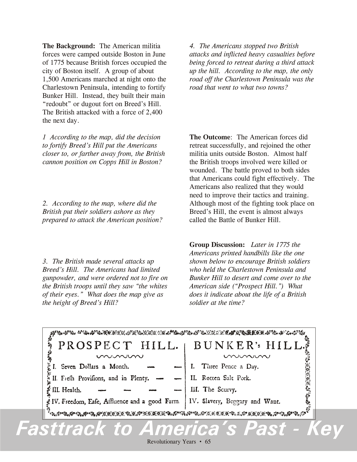| Fasttrack
to America's Past Teacher Key |
|
| Fasttrack
to America's Past Teacher Key |
|
 Page 64  Page 65 |
Pages 64
& 65 - The Battle of Bunker Hill These two pages give students practice at reading and interpreting a detailed map. The map shows a famous battle of the Revolution known as Bunker Hill. The map, page 64 The map shows the action on the Charlestown Peninsula on June 17, 1775. The peninsula lies just across the Charles River from Boston. It was mostly pasture land at the time, but did have a small town called Charlestown. The map shows the location of Bunker Hill and Breed's Hill. Although the battle is always called Bunker Hill, almost all the fighting took place on Breed's Hill. Notice that the map give the height of the hills. Study the map carefully, and find Morton's Hill, where the British landed to prepare their assault on the Americans who had built a redoubt, or dirt fort, on Breed's Hill. The long straight lines on the map show the lines of British cannon fire. Notice that Breed's hill is within reach of the British cannon on Copps Hill in Boston itself. The questions on page 65 will help students study the map and one of the key events of 1775. The map questions, page 65 1. According to the map... It put them closer to Copps Hill. 2. According to the map... Near Morton's Hill. 3. The British made several... It was 62 feet high. 4. The Americans stopped two... They could have been easily trapped, since there was only one narrow connection to the mainland.Group Discussion
questions, page 65 The picture shows a handbill, a sheet of
paper
which was
printed and handed out to the public. Notice that the letter "s" sometimes looks almost like a small "f" when it is inside a word. This was the normal style of lettering at the time. Have students read the descriptions under each heading. The handbill is a kind of advertisement for the American side. Like most advertisements, it exaggerates to some extent. The handbill tells a harsh story about the life of a British soldier in the 1770s. The pay was low. Food carried on the supply ships was often spoiled. Scurvy is a disease caused by a lack of vitamin C, which is found in fruit fruits like oranges and limes. The handbill concludes that the life of a British soldier is one of "Slavery, Beggary and Want." In reality, British soldiers were often better supplied than the American troops during the Revolution. |
|
Copyright Notice
Copyright 2018 by David Burns. All rights reserved. Illustrations and reading selections appearing in this work are taken from sources in the public domain and from private collections used by permission. Sources include: the Dover Pictorial Archive, the Library of Congress, The National Archives, The Hart Publishing Co., Corel Corporation and its licensors, Nova Development Corporation and its licensors, and others. Maps were created or adapted by the author using reference maps from the United States Geological Survey and Cartesia Software. Please see the home page for this title for more information. |